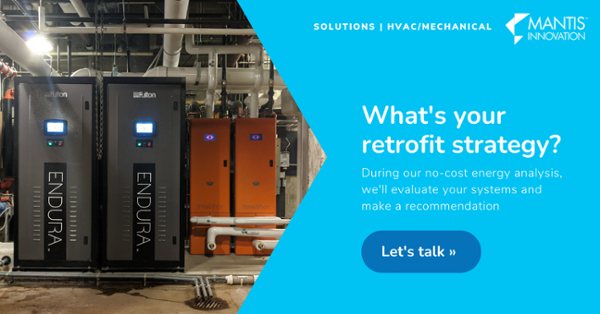Energy Efficiency | January 31, 2017
3 Challenges of a Hospital Retrofit
Hospital or healthcare facilities present many opportunities for improvement via a hospital retrofit project if efficiency measures are implemented with attention to their primary function. These are our "3 P's" to consider before starting a hospital energy efficiency project.
Considering the scale of a typical hospital campus, these facilities provide great potential for efficiency upgrades. Often comprised of multiple buildings employing a variety of lighting, controls, HVAC, and other mechanical elements, hospitals have many opportunities for improvement if efficiency projects are planned and implemented with strict attention to their primary functions.
Before planning a hospital retrofit, you should be able to manage the three primary challenges associated with a hospital efficiency project.
3 factors for consideration when taking on a hospital retrofit project for energy efficiency:
-
Patients and their safety
-
Policies including HIPAA and ICRA
-
Priorities of the facilities team
Working around patients during efficiency projects
The largest priority in a hospital is of course its patients, but this also presents a challenge when implementing energy upgrades. Facility managers, their teams and external firms brought in to perform efficiency improvements will inevitably be working around patients and their caregivers. This is a primary reason why hospitals are considered mission critical environments: there cannot be an event that shuts anything down (equipment, services, accessibility, etc.) as it could impact patient care.
Upgrades cannot impact the power supply or effectiveness of HVAC systems and projects have to be conducted with attention to patient care at the forefront. Taking precautions to avoid that potential risk of contamination is also something to consider, such as utilizing HEPA vacuums to minimize dust.
Policies affecting both healthcare facilities and engineering teams during a hospital retrofit
Any firm engaged to manage and implement efficiency projects must have knowledge about the privacy policies and other healthcare legislation that may impact their work to ensure the project is completed correctly and precisely according to law. Besides the well-known Health Insurance Portability and Accountability Act (HIPAA), another process energy teams must understand is the Infection Control Risk Assessment (ICRA). This policy ensures that teams working in the most critical environments in hospitals understand the necessary precautions to take.
Additional mandates may include those that confirm that both the hospital and the teams building out the energy projects know where everyone is working and when (these kinds of precautions are especially important in pediatric units).
The best efficiency firms have a deep understanding of the requirements in this environment, have experience with the different types of paperwork needed, and truly understand the critical nature of what goes on in a hospital beyond the upgrades, spaces, and equipment with which they are working.
Healthcare facilities management priorities
Many hospitals are part of a larger campus. Due to the sheer amount of infrastructure that they are responsible for, facility managers are primarily interested in minimizing the amount of ongoing maintenance an efficiency upgrade might require. Therefore, a lighting retrofit with advanced controls may not make sense for some hospitals due to the time and effort required to maintain the savings and keep the system properly running.
While this kind of sophisticated system can offer the maximum amount of efficiency possible in a retrofit, the lower cost of a system that achieves 80% of the savings while having a “set it and forget it” control strategy may ultimately fit best.
In the end, hospitals and sensitive healthcare environments must install systems that improve overall efficiency and are ultimately reliable for the millions of square feet that these institutions cover.
The patients, legislation, and scale of hospitals present a uniquely challenging work space for upgrades to energy-intensive systems. Despite these hurdles, implementing efficiency retrofits in healthcare facilities can offer significant return on investment payback and are well worth the effort.
The results of energy conservation projects bring not only financial benefit to these institutions through energy savings, but efficiency upgrades can greatly improve the quality of the patient experience as well.
Related Posts
Discover more content and insights from Mantis Innovation

The Cost of Inaction: Why Businesses Should Act Now on Energy Efficiency
In today's fast-paced business environment, the financial and operational losses businesses incur by delaying energy efficiency improvements, the "cost of inaction," is more relevant than ever.

In today’s AI era, human intelligence is the key to data center facility and energy optimization
Nowhere else in modern industry do artificial and human intelligence converge with such transformative potential as in the world of data centers. As AI's extraordinary growth accelerates demand for

Your Guide to LED Lighting for Business and Commercial Buildings
Never to be underestimated, LED lighting and well-designed lighting retrofits and upgrades offer businesses big improvements like reduced energy costs, reduced emissions, and improved working

Five Trends Driving Data Center Facility Energy Optimization
Today’s digital economy, commercial and industrial digitalization, and the recent explosion in artificial intelligence and machine learning (AI/ML) powered computing are driving massive growth in
